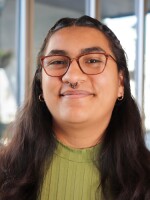Back in 2016, when Donald Trump was first elected, I was a 15-year-old student at Bay View High School. I remember that with bold speech against women and aggressive policies attacking immigrant communities, there was an air of uncertainty in my unusually quiet history class.
We received words of encouragement and support from our teachers. Now as an adult, I've revisited this memory. And I’m curious about if things have changed for those educators with a second Trump term.
Most Milwaukee Public Schools students are students of color and economically disadvantaged. Many come from immigrant communities. Trump's rhetoric on mass deportation and his attacks on DEI, may cause stress for some student, as might his cuts in education funding.
Katrina Halsey was a teacher at Bay View when I was a student. She’s since relocated to Riverside University High School. She remembers those first days after the 2016 election too. We talked at a cafe.

“As a teacher, it was extremely uncomfortable because you couldn't speak your mind in any way, shape or form. But you still had to make sure that you guided your kids in such a way where they knew to look forward to what might be coming by looking at had happened in the past," Halsey says.
Jay Bullock shared with me what he remembered about addressing students’ concerns at that time. Bullock is the current English department chair at Bay View High School.

“I think during the first Trump administration, there was an urgency for kindness—to sort of keep kindness at the forefront of what I was doing, the work that I was doing with them, how I was in class—just knowing that if they were to turn on the news, they might see something that could be stressful or upsetting,” Bullock says.
Since entering the Oval Office in 2025, Trump has signed more than 85 executive orders, many of which attack and defund vital resources for education and DEI programming. One policy called “Ending Radical Indoctrination in K-12 Schooling” has raised alarm bells among staff and students in how it could impact their education.
“It really kind of feels like all of the things that could be perceived as negative by the students. Those have all been turned up to like 11,” Bullock says.
Riverside, where Katrina Halsey teaches AP U.S and world history courses, has a focus on social justice and encourages students to participate in community and service-learning initiatives. Halsey notes the differences between her students at Bay View during the first Trump administration and her students at Riverside today. More are proactive politically. They’re organizing to register voters and going to her to understand the world around them.
"They are struggling to understand how one person can run through executive orders when it should be going the legislative branch signed by the executive branch and then verified by the judicial branch. The idea that those steps are being overlooked is something that they are struggling to accept,” Halsey says.
Dr. James Nelsen is the Social Studies Department Chair and teaches AP government at Golda Meir’s upper campus. He says in MPS, political instruction does not center Republicans and Democrats. Instead, the focus is on ideologies in general.

Nelsen says that using politics and current events as examples in his lessons are key for student's understanding.
“So, during the Obama administration, it might be examples from Obama as well as from Bush. You know the immediately preceding president. And then you move into the Trump administration. You'll compare him to Obama, and you'll compare Trump, and this Trump administration will be compared to whoever comes next. But you know, it's all about bringing, like, relevant examples that kids can remember that come from their own lives to understand these concepts in political science,” Nelsen says.
Bullock uses the political questions students bring to the classroom as learning opportunities. He points the students to sources like news articles, both pro-Trump and pro-Kamala Harris editorials and speeches from last summer’s political conventions.
“There has been students that will come in and say, you know, and this came up last week, but did Trump really cancel Black History Month and then having to say, well, all right, why don't look it up? See what actually happened and oh, it's just, you know, the federal government is not going to be doing any celebration. It's not cancelled. We can still do it here,” Bullock says.
For these MPS teachers, the main goal is to foster critical thinking and understanding to prepare students to be full participants in society after they leave their classrooms.






